Savages' Gemma Thompson on her artful, dynamic guitar playing
Art, exile and Dadaist verse - all through the six-string!
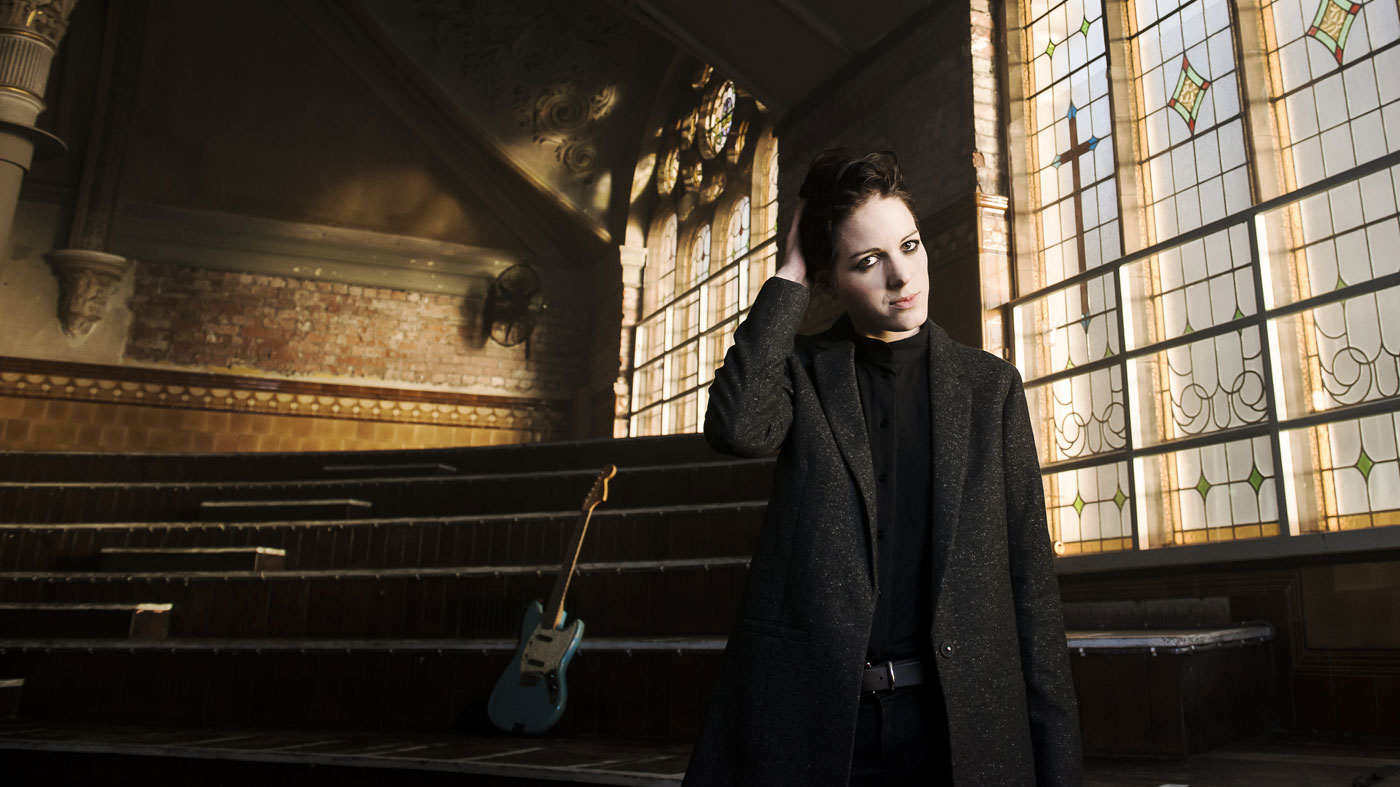
Introduction
It’s 5.30pm, and the late winter light is slowly seeping away from the majestic stained glass windows of Manchester’s Albert Hall. The former Methodist church creates an appropriately tasteful background as Savages’ Gemma Thompson patiently indulges our photographer.
Gemma’s extreme dynamics and feedback theatrics are at the heart of the band’s innovative approach to guitar music
The London post-punk band are due to play a sizeable show tonight, fresh off the back of their acclaimed second album, Adore Life. The record explores both the darkness and light of love and is a surprising, yet logical, step forward for a band that’s built itself around contrasts.
Along with frontwoman Jehnny Beth’s impassioned vocal delivery, Gemma’s extreme dynamics and feedback theatrics are at the heart of the band’s innovative approach to guitar music.
As Gemma winds up the shoot, she sits down with MusicRadar so we can pick our way through the mental maelstrom of a woman who’s quickly emerged as one of this generation’s most innovative and thought-provoking guitarists.
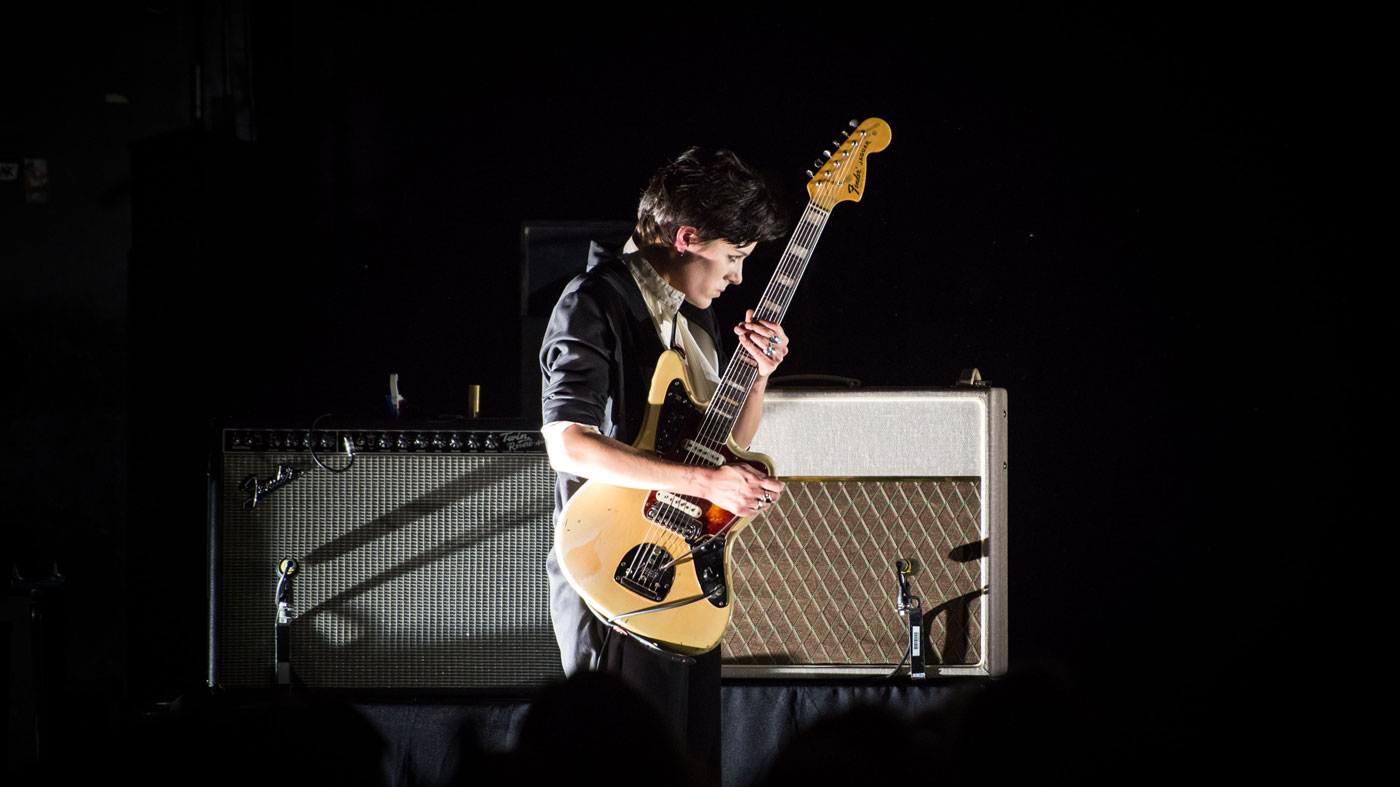
Noise guitar
What made you first start playing guitar?
“I moved to London to study art and I moved into a household of musicians. When I went to meet them they had all these records lined up on the wall, this record collection, and I thought, ‘Yeah, I’ll live with these guys.’
I learned how to do a dive bomb on a Strat with a Big Muff pedal and thought, ‘That’s an interesting sound!’
“I used to go and photograph their gigs and make flyers and all of that kind of stuff. Then I was working on little 16mm film pieces and I wanted to make the soundtracks, so my friends leant me all of their equipment and basically, I learned how to do a dive bomb on a Strat with a Big Muff pedal and thought, ‘That’s an interesting sound!’ So I just kind of carried on making noise before I learned how to play the instrument in a melodic way.
“I was asked to join a band as a noise guitarist, alongside a lead and rhythm guitarist. I’d never planned to be in a band or be a musician, but from there I started looking at artists like Blixa Bargeld and Rowland S Howard.”
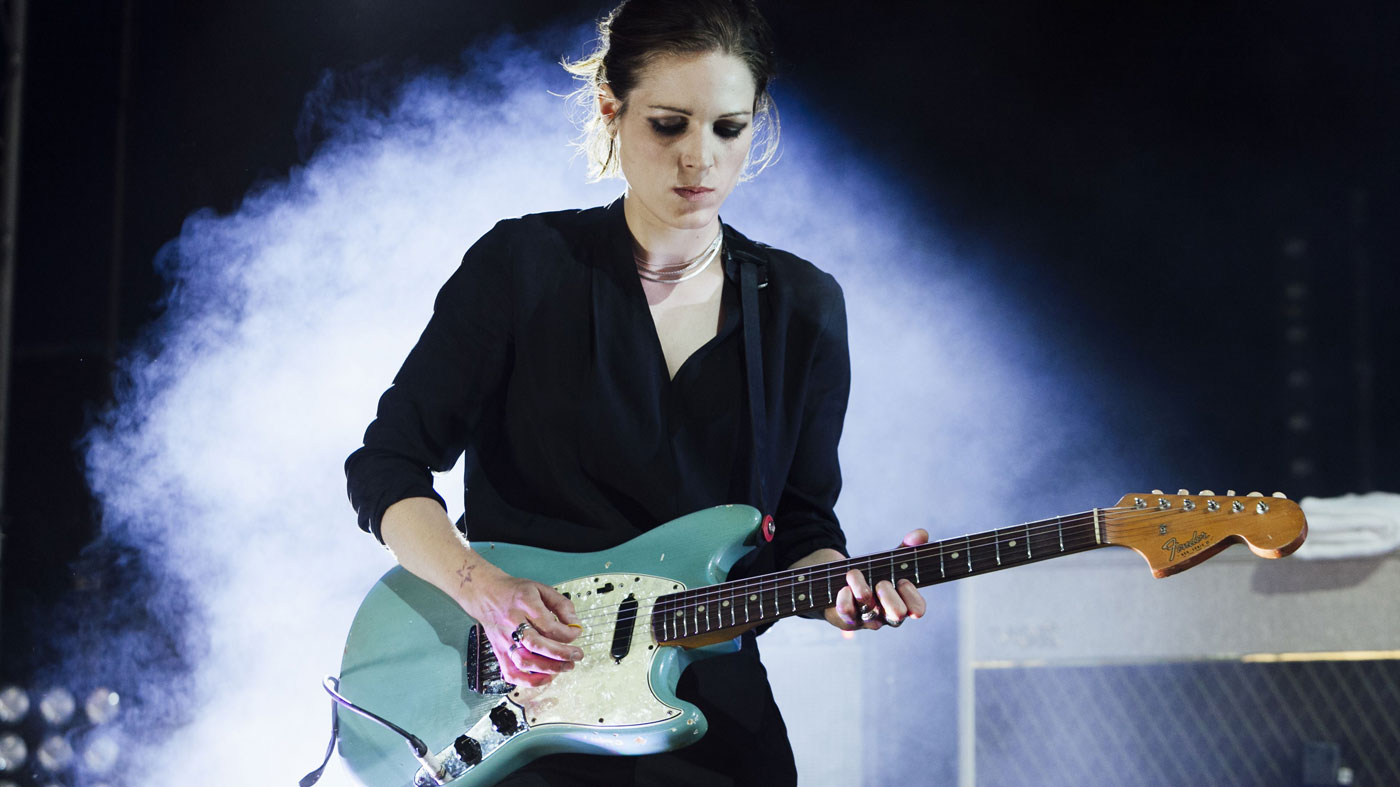
Arty 'Party
People might know Blixa Bargeld [Nick Cave And The Bad Seeds guitarist - Ed], but Rowland S Howard is a bit more obscure…
So much of it is about experience and how you apply yourself to an instrument
“Rowland S Howard was the guitarist from The Birthday Party and he was actually the very first Nick Cave And The Bad Seeds guitarist. He went on and played guitar in Crime & The City Solution and These Immortal Souls, and performed in his own right as Rowland S Howard.
“I remember the first thing I ever wanted to try and play on guitar was the line from Happy Birthday by The Birthday Party. It was very weird and very simple, a very strange line, and I was like, ‘I can’t play that unless I’m that person’.
“Suddenly it dawned on me that you had to go through all this to approach the instrument in a certain way. That was what interested me, not how long can you sit and learn something, even though that’s very useful, but that so much of it is about experience and how you apply yourself to an instrument.”
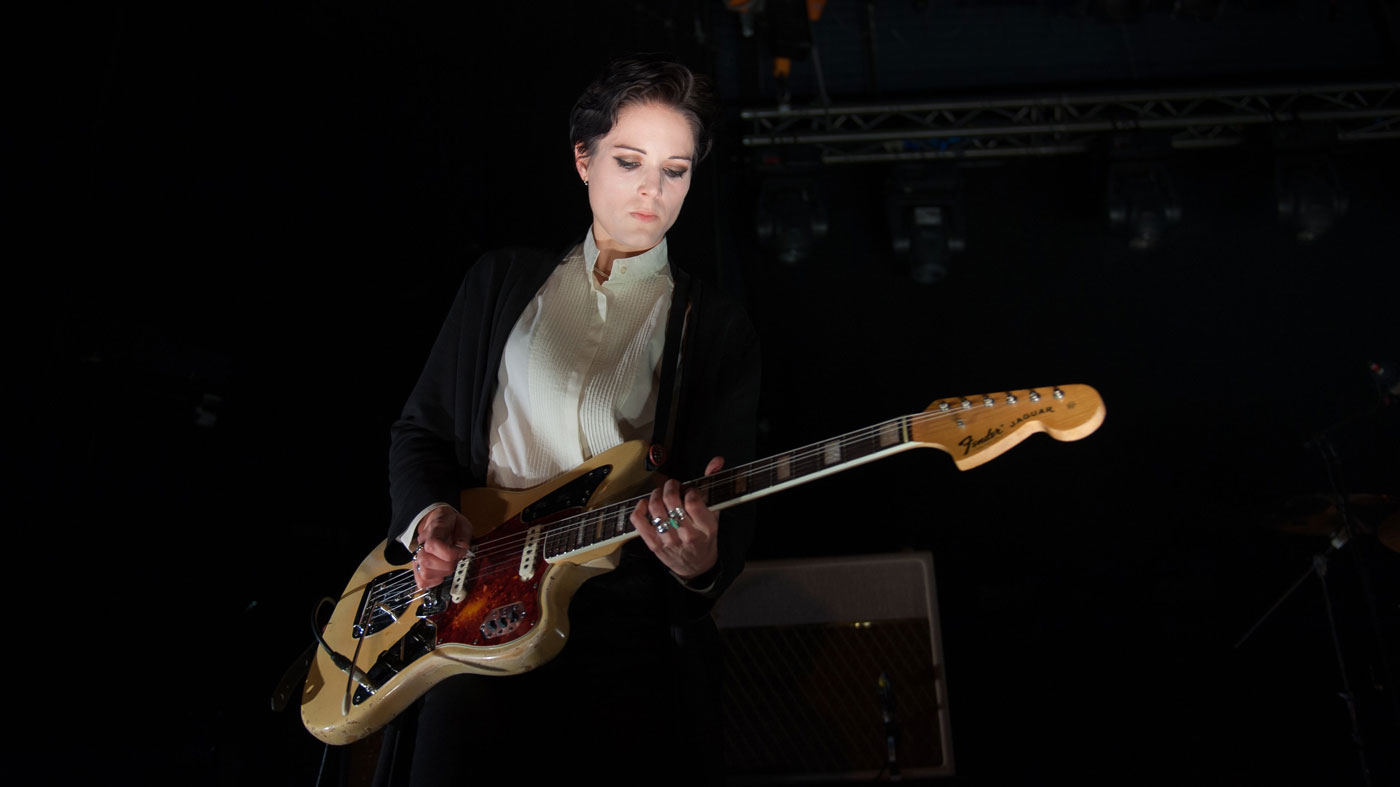
Listen to the Duke
Which other guitarists do you most respect?
“There’s another one called Duke Garwood. He’s done a lot of work with Mark Lanegan, but he’s an amazing folk singer-songwriter in his own right. He has this beautiful hollow-bodied 1960s Gibson and he joined Savages on the first US tour. He’s kind of my real-life guitar hero. I count him as a very good friend, as well.
Duke Garwood showed me that no one truly knows what they’re doing and that you find your own way
“He’s the first person that showed me that no one truly knows what they’re doing and that you find your own way. Before, I was going along thinking, ‘This is how I want to do things, but I don’t know if they’re right or wrong’. He taught me that you find a way and that’s how you do it.
“He works a lot with feedback with that Gibson hollowbody, manipulating it and moving it in certain ways to get this resonating, low-end feedback. He has to have his amps in a very specific place and I thought I was always a bit crazy for doing that, but learning from him I learned the art in doing that. So he’s a very much loved and respected figure [for me].”
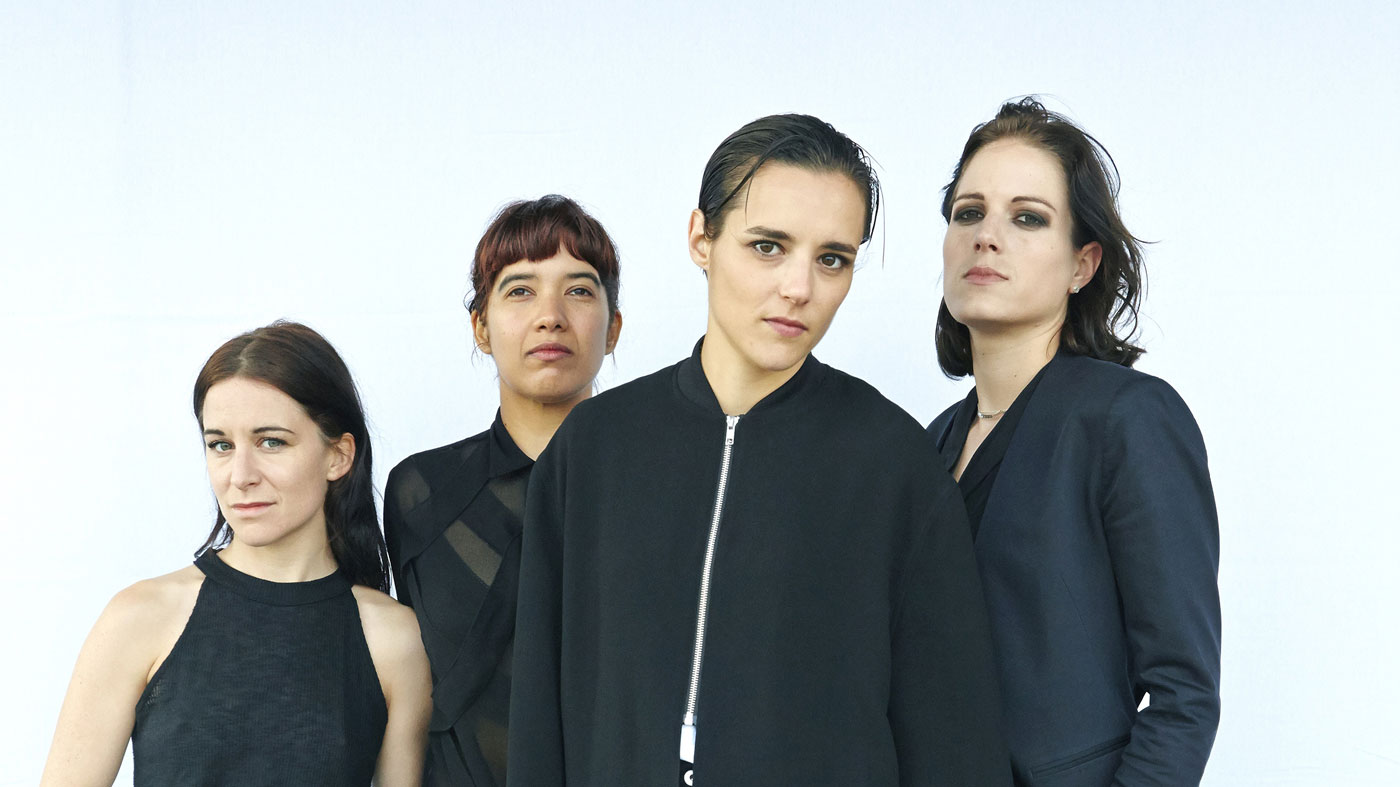
Poetry in motion
What are the non-musical influences on your approach to guitar playing?
“One thing I would mention is that we did a project with [London-based Japanese noise-rockers] Bo Ningen called Words To The Blind - and that stemmed from an idea when we recorded the first record, Silence Yourself.
We created a piece that was like sonic simultaneous poetry on a U-shaped stage
“We had loads of books in the studio, because we were hanging around. Some on the history of Dada [the early 20th century avant-garde art movement] and one in particular was about this form of simultaneous poetry.
“You had all of these exiles in 1916 in Zurich, Switzerland and they were running away from countries involved in the First World War. Lots of artists and philosophers came together and they were so angry that they could do nothing to stop this war hitting Europe, and they came up with this art form called simultaneous poetry.
“All of the voices in all of the languages would absurdly shout at the same time and create this uncontrollable chaos, then they would try to find some understanding from this chaos.
“So we created a piece that was like sonic simultaneous poetry on a U-shaped stage - with Taigen [Kawabe], the lead singer of Bo Ningen and Jehnny on the very end reciting French, Japanese and English poetry against the noise of the world, which was the musicians.
“We’ve performed it twice now. As you can imagine it’s quite a hard thing to organise. The first stage we built with our own hands on the back of a lorry!”
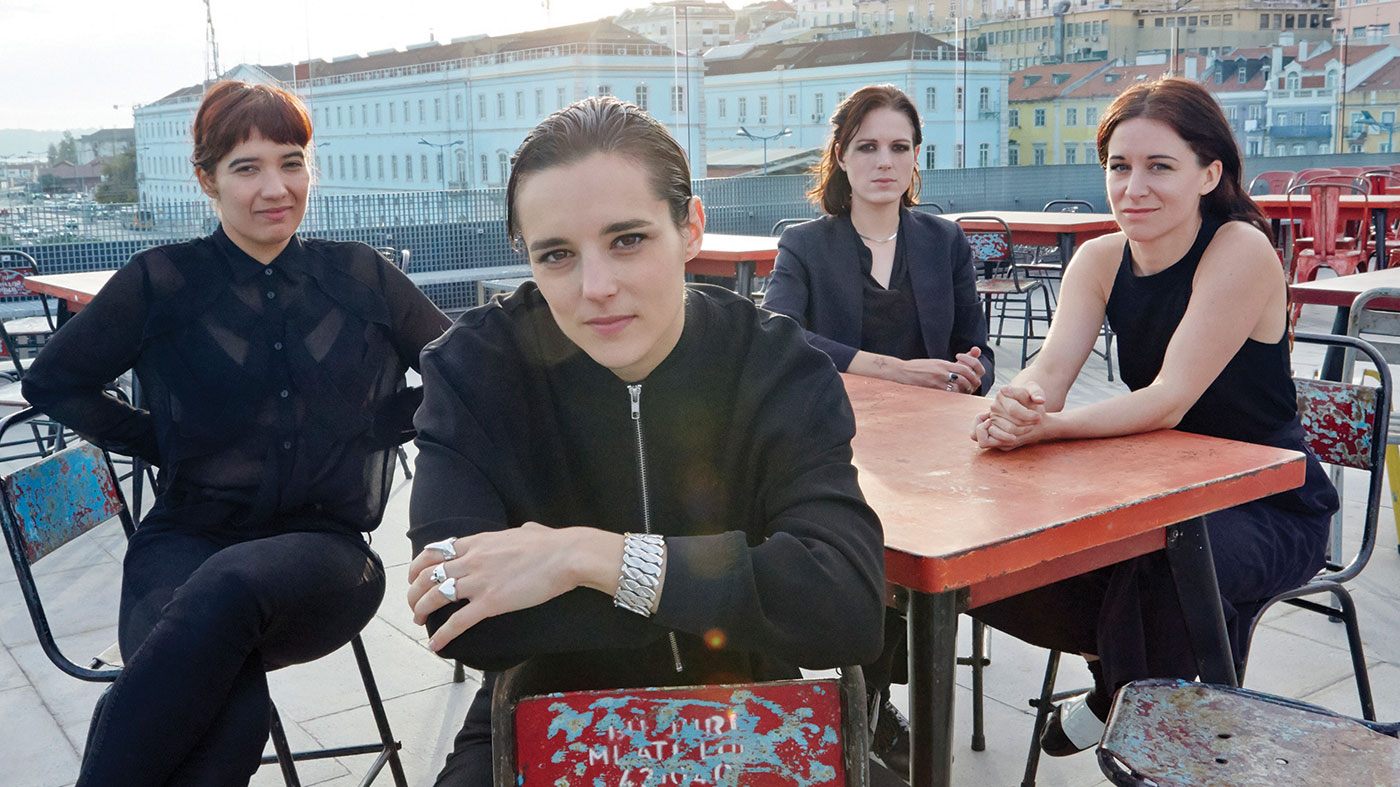
Love shines a light
‘Loud and fast’ was reportedly the mantra for the band’s early releases. What was the mantra for your Adore Life?
One of the main ideas behind this record was the exploration of love
“One of the main ideas behind this record was really the exploration of love. It’s one of the things that Jehn in particular never thought she would write about on the first record, but it’s an exploration of love and the darker themes of loss and risk and fear - you know, not just the sugar-coated twee ‘love’ - and also just a universal love of beings in the same room that come to listen to music. It’s an inspiration, or it’s healing, or it’s something to take away with you.”
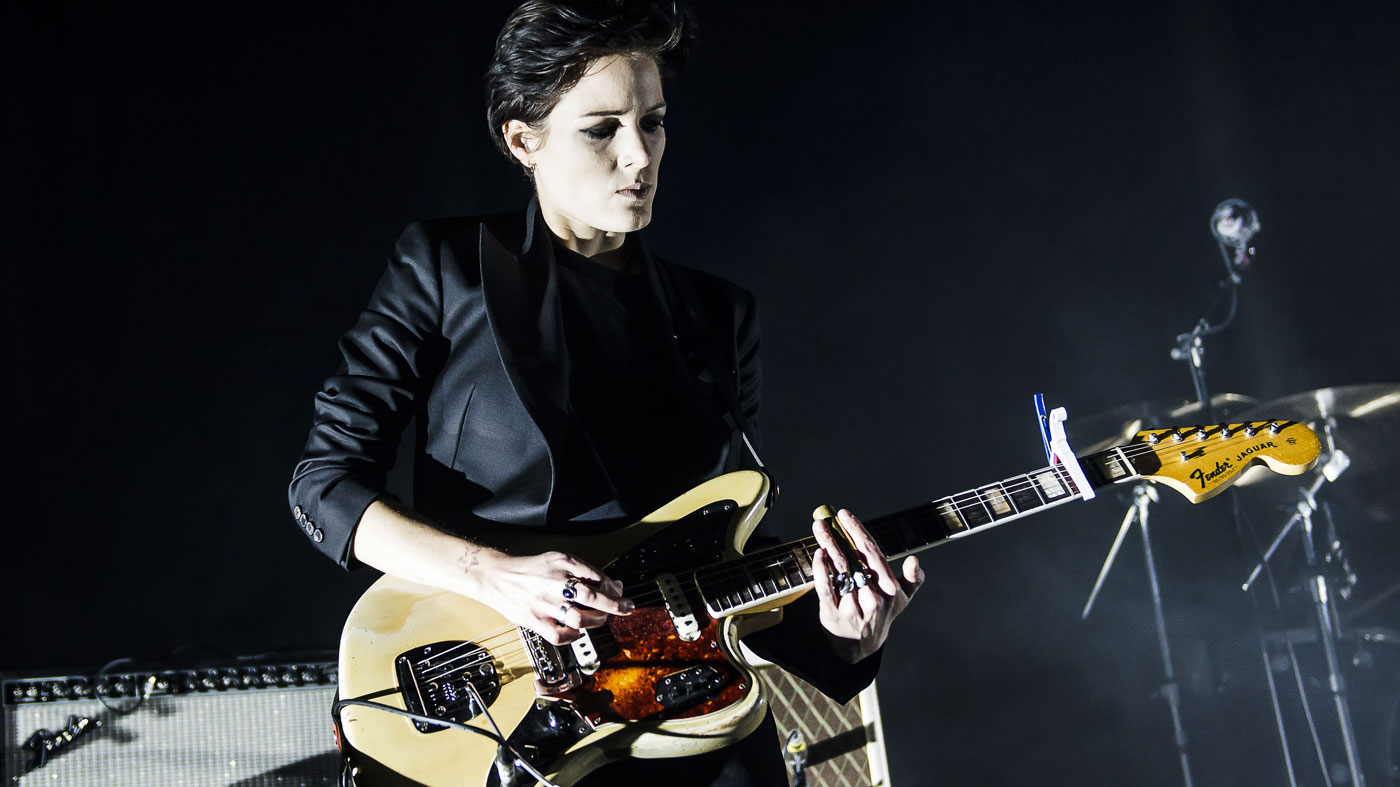
Dual guitar
This record is all about duality: light and dark, loud and quiet, love and passion. When and how did this idea first start to emerge?
You can use the stage as a platform to explore what you are and how far you want to go
“I think that stemmed from the first record as well. The idea of contrast: the softness and the hardness. Only by going to extremes in one thing, can you understand the softness.
“There’s a quote by Antonin Artaud where he said something like, ‘It’s only when you explore true cruelty that you can understand what true love means.’ You can use the stage as a platform to explore what you are and how far you want to go. You’re just a human being but you can use sound and volume as your chosen exertion. It’s interesting.”
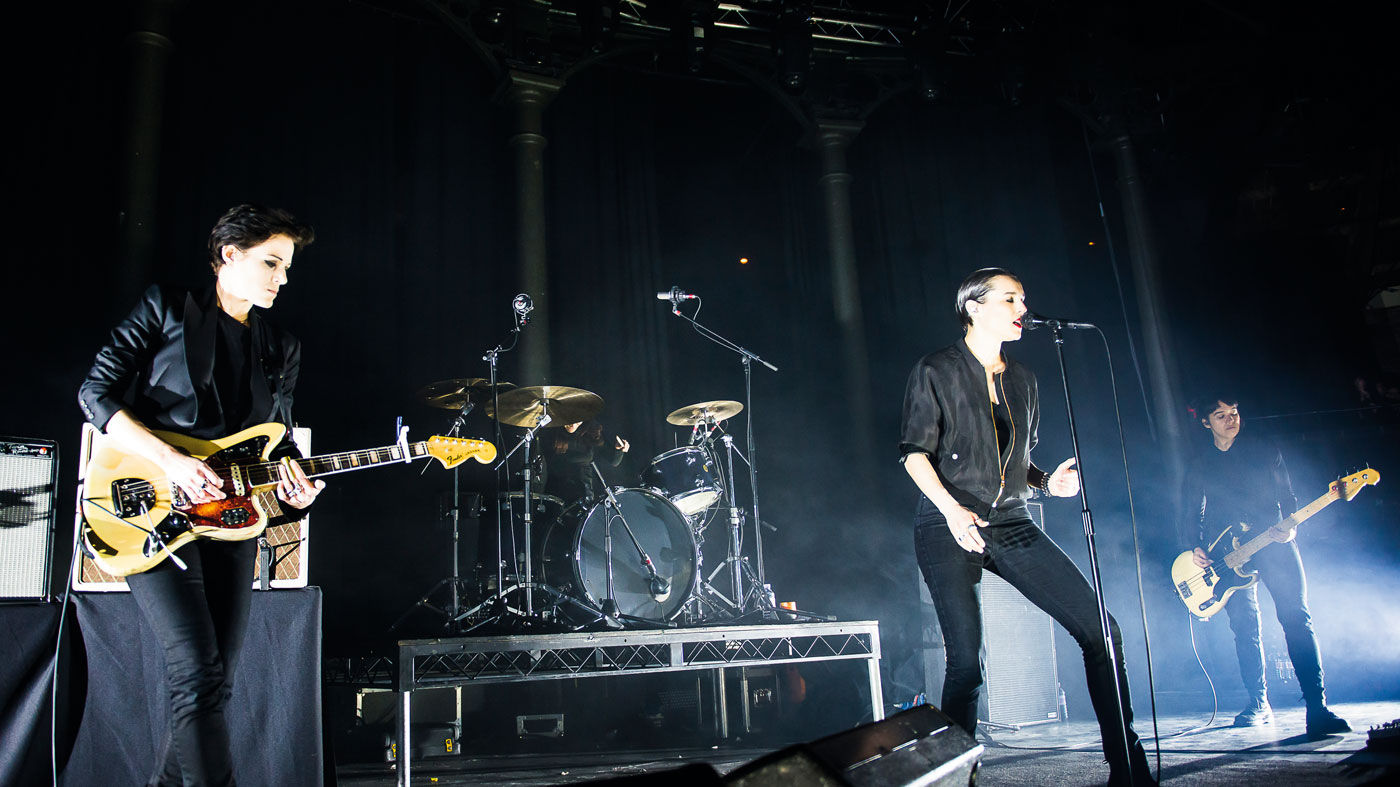
Let's push things forward
That duality really leaps out in your playing dynamics, too - where you go from scratching harmonics to towering riffs. Where do you think it manifests itself most successfully on the record?
We wanted to push every idea as much as we could
“Before we went in to record we wanted to push every idea as much as we could, so I’d say in songs like The Answer and Adore. Adore is this very melodic, almost ballad track, but we wanted to push that idea of making it this classically written song.
“Then The Answer came from this moving guitar riff that just went over and over again with the drums and it was just about having that as the whole song. Just pushing these ideas and being able to do that for this record was really exciting.”
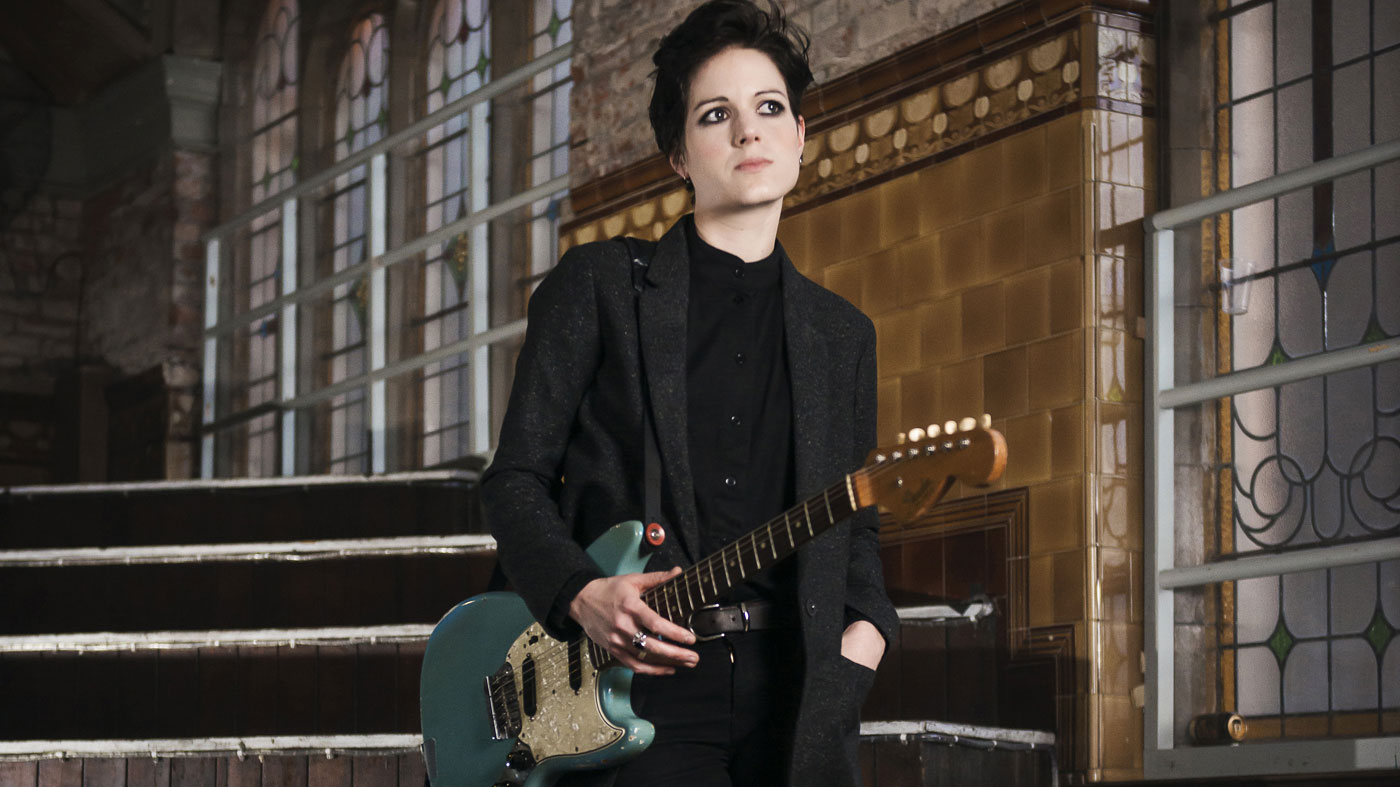
RAK attack
Your tones feel quite varied on the record. Do you use a lot of different gear or is that an illusion caused by technique?
“I’ve stuck to the core, the same things. I recently bought a Jaguar, because I had one for the recording and used it a lot, but everything was originally with my Duo-Sonic.
I’ve stuck to the core gear. I recently bought a Jaguar, but everything was originally with my Duo-Sonic
“The core of the sound I guess is the Vox AC30. We recorded at RAK Studios, which is a very comfortable place to record, and it has a lot of beautiful old amps as well - an old Fender Vibrolux, an old Hofner with tremolo… and we had all these things setup, like a little stable, so we could pick and choose.
“That was a lot of fun, but we’re a very minimal set-up still. We’re just guitar, drums, bass and vocals and there’s nothing else to it, really, so we’re just trying to take those recording techniques and see how we can perform it.
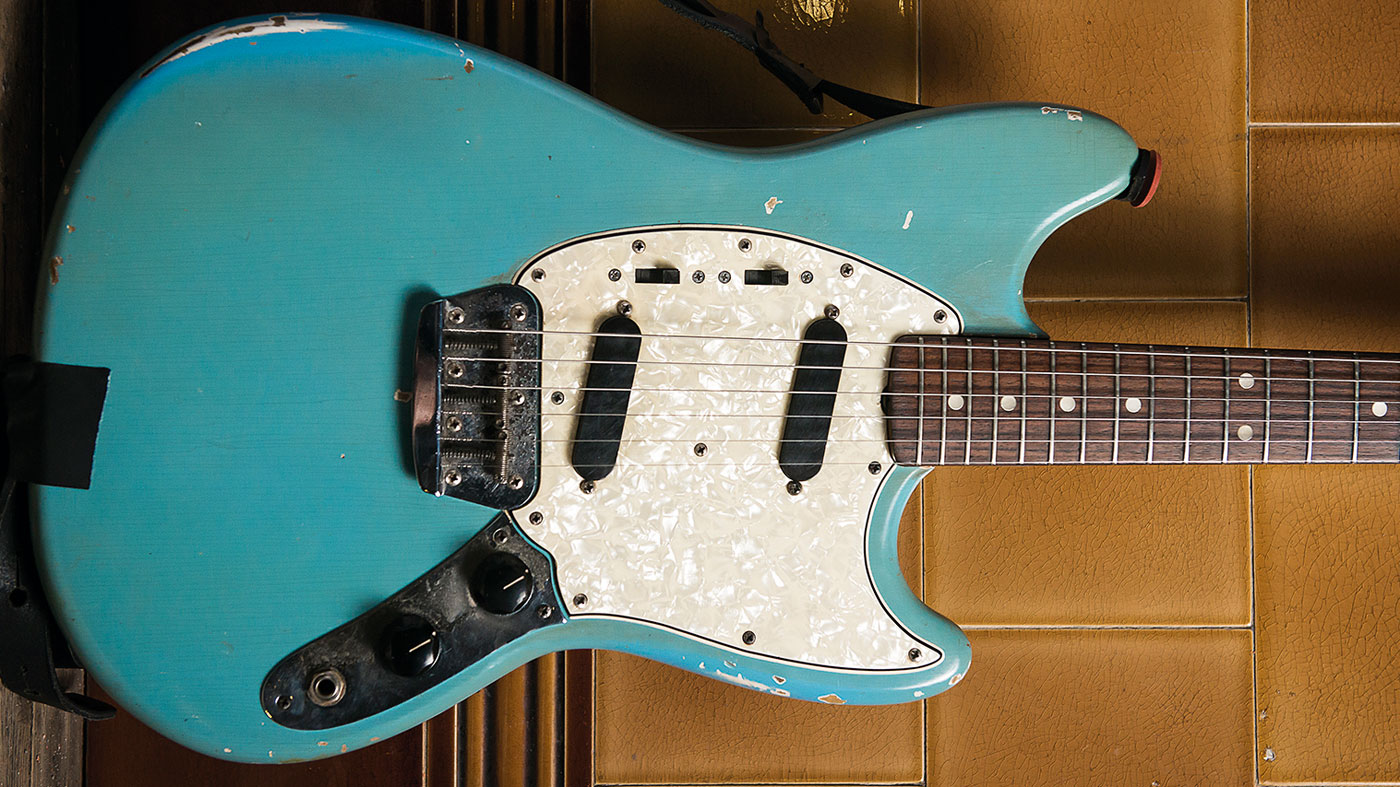
Off-set up
What attracts you to the Jaguar and Duo-Sonic as guitars?
“The Duo-Sonic kind of fell onto me, in a way. It’s a 1966 Duo-Sonic II. I was playing a Strat, originally, and I was in France, playing guitar for John & Jehn [Jehnny Beth’s pre-Savages band] and they had an old friend in Poitiers [in west France], who said, ‘You should play this guitar. I’m going to lend it to you for two days.’
It’s a wonderful guitar. It’s very intuitive and easy to play and it has wonderful feedback
So I sat with it for two days in this house in France and fell in love with it. He said, ‘Look, if you don’t have it, my eight-year- old daughter is going to have it.’ So I came back to England and thought about it and thought, ‘I have to have that guitar’, so it got sent over on a lorry and I had to go stand in an industrial estate on a corner at this particular moment that this massive lorry was coming past, in order to flag it down and get my guitar, which was an awkward situation.
“It’s a wonderful guitar. It’s very intuitive and easy to play and it has wonderful feedback on it, but the Jag has a much heavier tone. Although it has a similar way of being played. They both do their thing, and you throw it around and they react very particularly to certain sounds, particularly distortion pedals.”
What about effects? Do you have any essential pedals?
“I have a Strymon [Flint] reverb and tremolo pedal that I started using while recording and that’s a beautiful sound. I’d love to try more Strymons.Then I use the MXR Distortion+ quite a bit, but not so much with the Jaguar, it’s much easier to use with the Duo-Sonic. Most of the distortion is coming from the pedals. I use an [Fulltone] OCD overdrive and a [Crowther Audio] Hotcake pedal from New Zealand, and a Maxon [OD-9] Tube Screamer as well, mainly for changing the tone of distortion sounds.”

Live lives
You’ve said before that “not enough bands question the context of their music”. It struck us as something guitarists are often guilty of - that mindless repetition. How do you go about questioning it?
We felt there weren’t enough musicians that played like it was the last show of their lives
“I think it stems from when we created this band. We were trying to fill a gap that we saw at the time. There was a wash of indie bands and there were a handful of musicians that, before Jehn and I knew each other, we both went to see. Bands like Liars and Selfish C*** who were these dramatic performance artists. Bo Ningen as well, who are amazing performers.
“We felt there weren’t enough musicians that played like it was the last show of their lives and put everything into what they were doing. You meet these boys, Bo Ningen, and they’re the sweetest, most polite people ever, but when you see them onstage it’s like the end of the world. I just want to see musicians like that.”
Savages second album, Adore Life, is out now on Matador Records
Matt is a freelance journalist who has spent the last decade interviewing musicians for the likes of Total Guitar, Guitarist, Guitar World, MusicRadar, NME.com, DJ Mag and Electronic Sound. In 2020, he launched CreativeMoney.co.uk, which aims to share the ideas that make creative lifestyles more sustainable. He plays guitar, but should not be allowed near your delay pedals.


